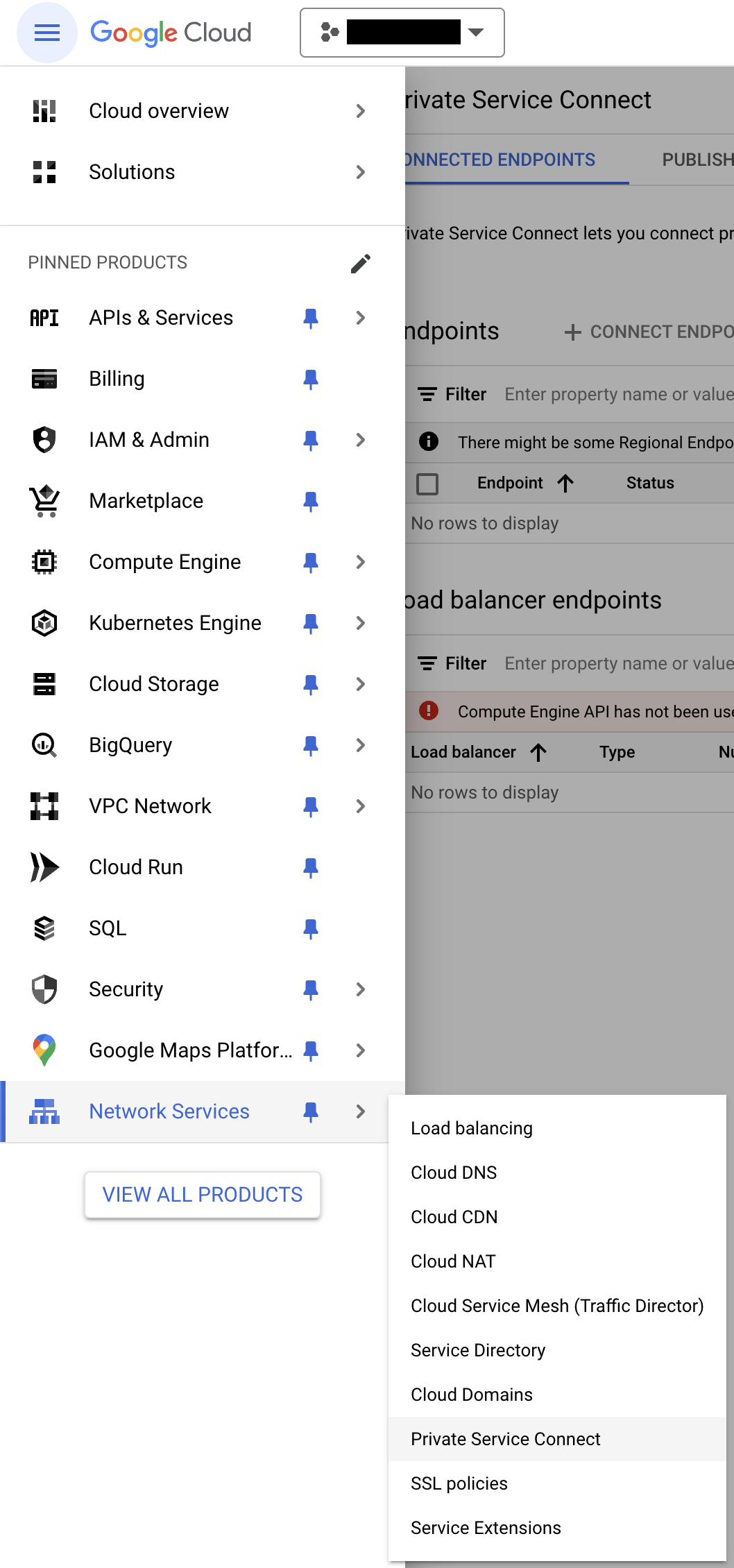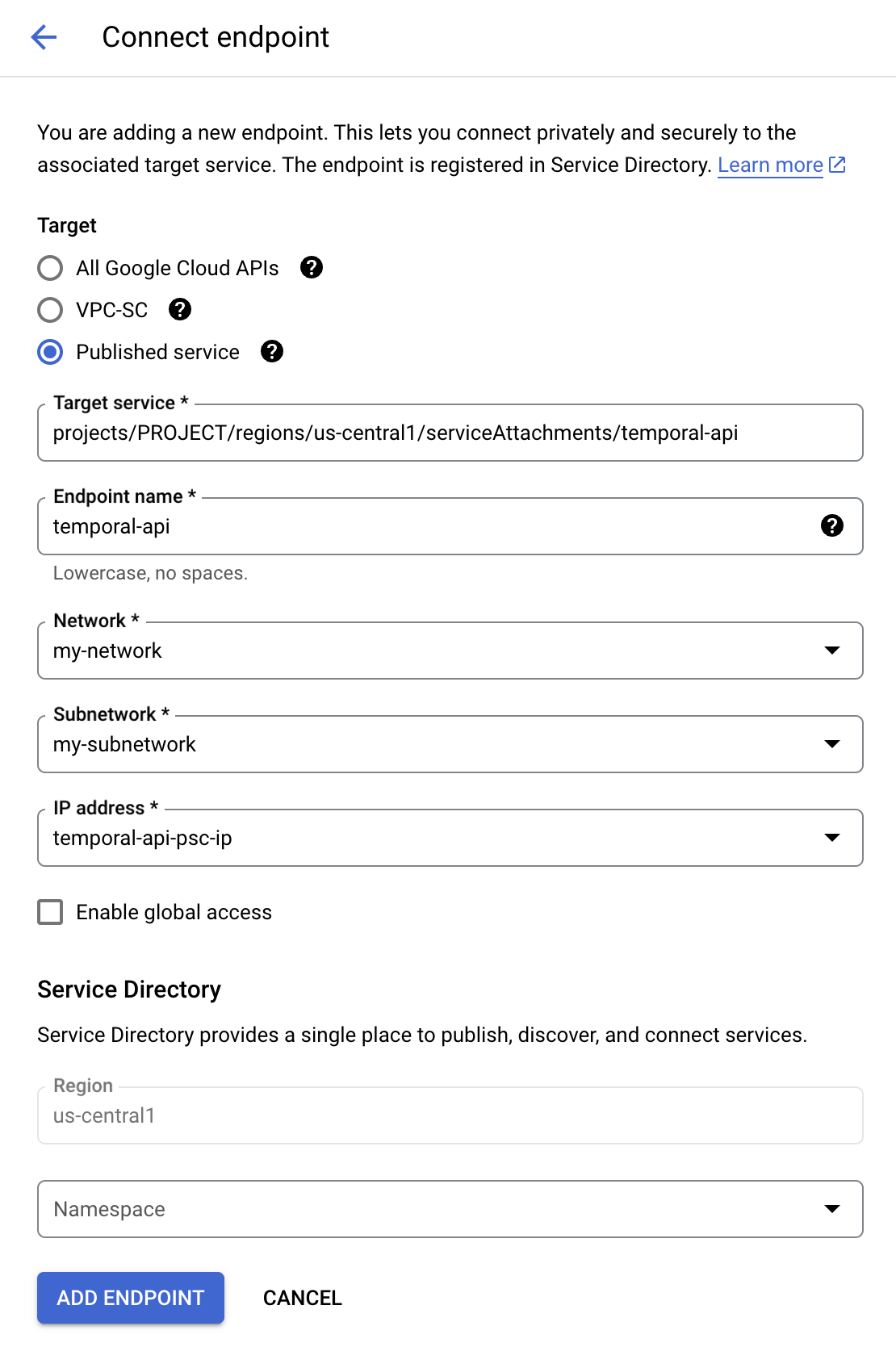Google Private Service Connect Connectivity
Google Cloud Private Service Connect allows you to open a path to Temporal without opening a public egress. It establishes a private connection between your Google Virtual Private Cloud (VPC) and Temporal Cloud. This one-way connection means Temporal cannot establish a connection back to your service. This is useful if normally you block traffic egress as part of your security protocols. If you use a private environment that does not allow external connectivity, you will remain isolated.
Automatic failover via Temporal Cloud DNS is not currently supported with GCP Private Service Connect. If you use GCP Private Service Connect, you must manually update your workers to point to the active region's Private Service Connect endpoint when a failover occurs.
Requirements
Your GCP Private Service Connect connection must be in the same region as your Temporal Cloud namespace. If using replication for High Availability, the PSC connection must be in the same region as one of the replicas.
Creating a Private Service Connect connection
Set up Private Service Connect with Temporal Cloud with these steps:
-
Open the Google Cloud console
-
Navigate to Network Services, then Private Service Connect. If you haven't used Network Services recently, you might have to find it by clicking on View All Products at the bottom of the left sidebar.

-
Go to the Endpoints section. Click on Connect endpoint.

-
Under Target, select Published service, this will change the contents of the form to allow you to fill the rest as described below

-
For Target service, fill in the Service name with the Private Service Connect Service Name for the region you’re trying to connect to:
Region Private Service Connect Service Name asia-south1projects/prod-d5spc2sfeshws33bg33vwdef7/regions/asia-south1/serviceAttachments/pl-7w7tweurope-west3projects/prod-kwy7d4faxp6qgrgd9x94du36g/regions/europe-west3/serviceAttachments/pl-acgshus-central1projects/prod-d9ch6v2ybver8d2a8fyf7qru9/regions/us-central1/serviceAttachments/pl-5xzngus-east4projects/prod-y399cvr9c2b43es2w3q3e4gvw/regions/us-east4/serviceAttachments/pl-8awsyus-west1projects/prod-rbe76zxxzydz4cbdz2xt5b59q/regions/us-west1/serviceAttachments/pl-94w0x -
For Endpoint name, enter a unique identifier to use for this endpoint. It could be for instance
temporal-apiortemporal-api-<namespace>if you want a different endpoint per namespace. -
For Network and Subnetwork, choose the network and subnetwork where you want to publish your endpoint.
-
For IP address, click the dropdown and select Create IP address to create an internal IP from your subnet dedicated to the endpoint. Select this IP.
-
Check Enable global access if you intend to connect the endpoint to virtual machines outside of the selected region. We recommend regional connectivity instead of global access, as it can be better in terms of latency for your workers. Note: this requires the network routing mode to be set to GLOBAL.
-
Click the Add endpoint button at the bottom of the screen. If successful, the status of your new endpoint will appear as Accepted. Take note of the IP address that has been assigned to your endpoint, as it will be used to connect to Temporal Cloud.
-
You can now use GCP Private Service Connect. You can use the IP address of the previous step to connect to Temporal Cloud using port 7233. To establish a valid mTLS session, you must override the TLS server name used for the connection to
<namespace>.<account>.tmprl.cloud.
GCP Private Service Connect services are regional. Individual Namespaces do not use separate services.
Once set up, you can test your Private Service Connect connectivity using the following methods.
When connecting, you must override the TLS server name to target your Namespace’s individual hostname (<namespace>.<account>.tmprl.cloud) to establish a valid mTLS session:
-
The Temporal CLI, using the
--tls-server-nameparameter to override the TLS server name. For example:temporal workflow count \
--address <IP address of the PSC endpoint>:7233 \
--tls-cert-path /path/to/client.pem \
--tls-key-path /path/to/client.key \
--tls-server-name <namespace>.<account>.tmprl.cloud \
--namespace <namespace> -
Non-Temporal tools like grpcURL, useful for testing from environments that restrict tool usage, using the
-servernameparameter to override the TLS server name. For example:grpcurl \
-servername <name>.<account>.tmprl.cloud \
-cert /path/to/client.pem \
-key /path/to/client.key \
<IP address of the PSC endpoint>:7233 \
temporal.api.workflowservice.v1.WorkflowService/GetSystemInfo -
Temporal SDKs, by setting the endpoint server address argument to the Private Service Connect endpoint (
<IP address of the PSC endpoint>:7233) and using the TLS configuration options to override the TLS server name.
When using API keys for namespace authentication, the TLS server name must be set to the Namespace's gRPC endpoint (<region>.<cloud_provider>.api.temporal.io) using one of the following methods:
-
The Temporal CLI, using
--tls-server-nameparameter to override the TLS server name and the--tlsflag to enforce the use of TLS. For example:temporal workflow count \
--address <IP address of the PSC endpoint>:7233 \
--namespace <namespace>.<account> \
--api-key <api_key> \
--tls-server-name <region>.<cloud_provider>.api.temporal.io \
--tls -
Non-Temporal tools like grpcURL, setting the
authorizationandtemporal-namespaceheaders, and the-servernameparameter to override the TLS server name. For example:grpcurl \
-H "authorization: Bearer <api_key>" \
-H "temporal-namespace: <namespace>.<account>" \
-servername <region>.<cloud_provider>.api.temporal.io \
<IP address of the PSC endpoint>:7233 \
temporal.api.workflowservice.v1.WorkflowService/GetSystemInfo
Configuring Private DNS for GCP Private Service Connect
Why configure private DNS?
When you connect to Temporal Cloud through GCP Private Service Connect you normally must:
- Point your SDKs/Workers at the Private Service Connect endpoint IP address and
- Override the Server Name Indicator (SNI) so that the TLS handshake still presents the public Temporal Cloud hostname (e.g.,
my-namespace.my-account.tmprl.cloud).
By creating a private Cloud DNS zone (PZ) that maps the public TemporalC Cloud hostname (or the region hostname) directly to the PSC endpoint IP address, you can:
- Keep using the standard Temporal Cloud hostnames in code and configuration.
- Eliminate the need to set a custom SNI override.
- Make future endpoint rotations transparent—only the DNS record changes.
This approach is optional; Temporal Cloud works without it, but it streamlines configuration and operations.
Prerequisites
| Requirement | Notes |
|---|---|
| Google Cloud VPC Network with DNS enabled | PSC endpoints and the DNS zone must live in (or be attached to) the same network. |
| Private Service Connect endpoint for Temporal Cloud | Create an endpoint and reserve an internal IP in the namespace region |
| Cloud DNS API enabled and roles/dns.admin permissions | Needed to create private zones and records. |
| Namespace details | Determines which hostname pattern you override (table below). |
Choose the override domain and endpoint
| Temporal Cloud setup | Use this PHZ domain | Example |
|---|---|---|
| Single-region namespace with mTLS auth | <account>.tmprl.cloud | payments.abcde.tmprl.cloud ↔ X.X.X.X |
| Multi-region namespace or API-key auth | region.tmprl.cloud | aws-us-east-1.region.tmprl.cloud ↔ X.X.X.X |
Step-by-step instructions
1. Collect your PSC endpoint IP address
# List the forwarding rule you created for the endpoint
gcloud compute forwarding-rules list \
--filter="NAME:<endpoint-name>" \
--format="value(IP_ADDRESS)"
# Example output: 10.1.2.3
Save the internal IP -- you will point the A record at it.
2. Create a Cloud DNS private zone
- Open Network Services → Cloud DNS → Create zone.
- Select zone type Private.
- Enter a Zone name (e.g.,
temporal-cloud). - Enter a DNS name based on the table above (e.g.,
payments.abcde.tmprl.cloudoraws-us-east-1.region.tmprl.cloud). - Select Add networks and choose the Project and Network that contains your PSC endpoint.
- Click Create.
3. Add an A record
Inside the new zone, add a standard A record:
| Field | Value |
|---|---|
| DNS name | the namespace endpoint (e.g. payments.abcde.tmprl.cloud) |
| Resource record type | A |
| TTL | 60s is typical, but you can adjust as needed. |
| IPv4 Address | the internal IP address of your PSC endpoint (e.g. 10.1.2.3) |
4. Verify DNS resolution from inside the Network
dig payments.abcde.tmprl.cloud
If the hostname resolves to the PSC endpoint IP address from a VM in the bound network, the override is working.
Updating your workers/clients
With private DNS in place, configure your SDKs exactly as the public-internet examples show (filling in your own namespace):
clientOptions := client.Options{
HostPort: "payments.abcde.tmprl.cloud:7233",
Namespace: "payments",
// No TLS SNI override needed
}
The DNS resolver inside your network returns the private endpoint IP address, while TLS still validates the original hostname—simplifying both code and certificate management.
Available GCP regions, PSC endpoints, and DNS record overrides
The following table lists the available Temporal regions, PrivateLink endpoints, and regional endpoints used for DNS record overrides:
North America - Iowa (us-central1)
- Cloud API Code:
gcp-us-central1 - Regional Endpoint:
gcp-us-central1.region.tmprl.cloud - Private Service Connect Service Attachment URI:
projects/prod-d9ch6v2ybver8d2a8fyf7qru9/regions/us-central1/serviceAttachments/pl-5xzng - Same Region Replication: Not Available
- Multi-Region Replication:
gcp-us-west1gcp-us-east4
- Multi-Cloud Replication:
aws-ca-central-1aws-us-east-1aws-us-east-2aws-us-west-2
North America - Oregon (us-west1)
- Cloud API Code:
gcp-us-west1 - Regional Endpoint:
gcp-us-west1.region.tmprl.cloud - Private Service Connect Service Attachment URI:
projects/prod-rbe76zxxzydz4cbdz2xt5b59q/regions/us-west1/serviceAttachments/pl-94w0x - Same Region Replication: Not Available
- Multi-Region Replication:
gcp-us-central1gcp-us-east4
- Multi-Cloud Replication:
aws-ca-central-1aws-us-east-1aws-us-east-2aws-us-west-2
North America - Northern Virginia (us-east4)
- Cloud API Code:
gcp-us-east4 - Regional Endpoint:
gcp-us-east4.region.tmprl.cloud - Private Service Connect Service Attachment URI:
projects/prod-y399cvr9c2b43es2w3q3e4gvw/regions/us-east4/serviceAttachments/pl-8awsy - Same Region Replication: Not Available
- Multi-Region Replication:
gcp-us-central1gcp-us-west1
- Multi-Cloud Replication:
aws-ca-central-1aws-us-east-1aws-us-east-2aws-us-west-2
Europe - Frankfurt (europe-west3)
- Cloud API Code:
gcp-europe-west3 - Regional Endpoint:
gcp-europe-west3.region.tmprl.cloud - Private Service Connect Service Attachment URI:
projects/prod-kwy7d4faxp6qgrgd9x94du36g/regions/europe-west3/serviceAttachments/pl-acgsh - Same Region Replication: Not Available
- Multi-Region Replication:
- None
- Multi-Cloud Replication:
aws-eu-central-1aws-eu-west-1aws-eu-west-2
Asia Pacific - Mumbai (asia-south1)
- Cloud API Code:
gcp-asia-south1 - Regional Endpoint:
gcp-asia-south1.region.tmprl.cloud - Private Service Connect Service Attachment URI:
projects/prod-d5spc2sfeshws33bg33vwdef7/regions/asia-south1/serviceAttachments/pl-7w7tw - Same Region Replication: Not Available
- Multi-Region Replication:
- None
- Multi-Cloud Replication:
aws-ap-northeast-1aws-ap-northeast-2aws-ap-south-1aws-ap-south-2aws-ap-southeast-1aws-ap-southeast-2